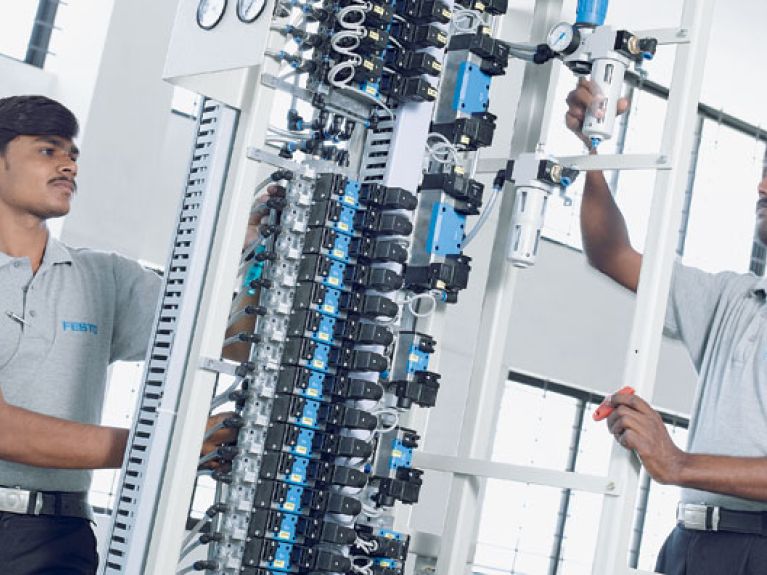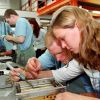Attractive model
More and more Asian countries are introducing dual vocational education and training programmes.

Young people in work overalls and safety shoes are operating small robots that extend their gripper arms in all directions. This scene at the Bosch Mechatronics Lab in Bangalore, India, is identical to the one you would find at many of the company’s German plants. The apprentices here are receiving a dual vocational training based on the German model. Bosch trains 180 apprentices under conditions similar to those of a practical work situation. The German company’s training centre in Bangalore serves as a model for Indian industry. Despite the country’s large population and a very high proportion of young people – 500 million people are under 25 years of age – India has a striking shortage of skilled specialists resulting from its strong economic growth. According to estimates, only 3% of all employees have formal work training. It is estimated that there will a shortage of 50 million specialists in 2020. The government has set itself the goal of improving the training of 500 million people by 2022.
The German dual vocational training system has proven advantages as a reference model for a reform of the education system. It involves an average of four days a week at work and one day at the vocational school. That means trainees gain practical experience from the very start and employers have an interest in taking on their apprentices permanently at the end of their training. According to one study, nearly half (44%) of successful German trainees subsequently work in the field for which they trained. This is also one of the reasons why the Organisation for Economic Cooperation and Development (OECD) praised the system in 2013. According to the Skills beyond School study, the transition from school to work runs “remarkably smoothly” in Germany. In 2008, over 90% of 15- to 24-year-olds found employment after leaving school or were able to continue their education. Compared to other countries this is a high percentage. Furthermore, Germany has the lowest youth unemployment rate in Europe at 7.4%. The dual training system undoubtedly contributes to this success story.
This success has drawn attention to the German training model in many countries. In order to better respond to the increasing number of enquiries about the dual training system, in September 2013 the Federal Government set up the German Office for International Cooperation in Vocational Education and Training (GOVET), which is attached to the Federal Institute for Vocational Education and Training (BIBB). Departments, employees’ and employers’ representatives and chambers of industry and commerce regularly meet at the GOVET round table under the auspices of the Federal Ministry of Education and Research (BMBF) to discuss issues and coordinate activities. “It is not GOVET’s goal here to transfer the German vocational training system to other countries 1:1. It has to be adapted to local conditions,” emphasises Maren Verfürth, the member of staff responsible for India. Nevertheless, interest in the German model remains unbroken, says Verfürth: since GOVET was set up, an increasing number of interested parties have been in touch. People from over 100 countries seek information from the organisation’s website every month. “The number of enquiries has remained constant, but their quality has increased enormously,” says Verfürth.
Also attached to BIBB is iMOVE, a BMBF export initiative that aims to promote international collaboration and the initiation of cooperation and business relationships in vocational training and continuing education. This is also where specialist exchange takes place between representatives of Indian and German education. “Against this background, for example, iMOVE identified German partners for the planning and establishment of a government training centre for energy-efficient construction on behalf of the Indian Ministry of Human Resource Development. Working for Indian stakeholders from industry, the education sector or government organisations, iMOVE will find suitable partners from Germany with the desired expertise,” explains Ulrich Meinecke, the Head of iMOVE. In recent years, iMOVE has built up a large network of suppliers, Indian partner organisations and Indian firms. iMOVE has maintained an office in New Delhi since 2012 because India is one of the most interesting locations for education cooperation: “We received exactly 143 enquiries about India in 2015,” says Meinecke. Only recently, at the end of 2015, the Association for European Social Work, Education and Training (VESBE) opened an Indo-German Competence Academy in Mumbai jointly with iMOVE. Initially, the academy is offering a vocational training programme in the field of water purification and waste treatment, but it intends to identify and offer programmes in other work sectors.
German chambers of commerce abroad (AHKs) also play a far from minor role in introducing elements of dual training into the vocational education systems of selected countries. The German Chambers Worldwide Network for Cooperative Workbased Vocational Education and Training – or simply VETnet – is also active in Asia in India and Thailand. It is attracting great interest. Increasingly, it is not only German companies that are taking part in dual training programmes abroad, but also local firms. This applies especially to industrial and technical occupations. On the initiative of AHK Vietnam in Ho Chi Minh City, for example, cooperation agreements were signed in June 2016 between Bosch Vietnam, LILAMA2 College and GIC/AHK Vietnam with regard to dual training programmes for mechatronics technicians. This programme is the second vocational training scheme, alongside that for industrial mechanics, which has been carried out at Bosch Vietnam since 2013. Bosch Vietnam will be training twelve apprentices for this occupation from October 2016. They do 75% of their training at Bosch’s own training centre in Dong Nai and 25%, the theoretical part, at LILAMA2 College. ▪
Petra Schönhöfer

